Intro/Interview: Yasuyuki Takeo.
Photography: Riku Shinde.
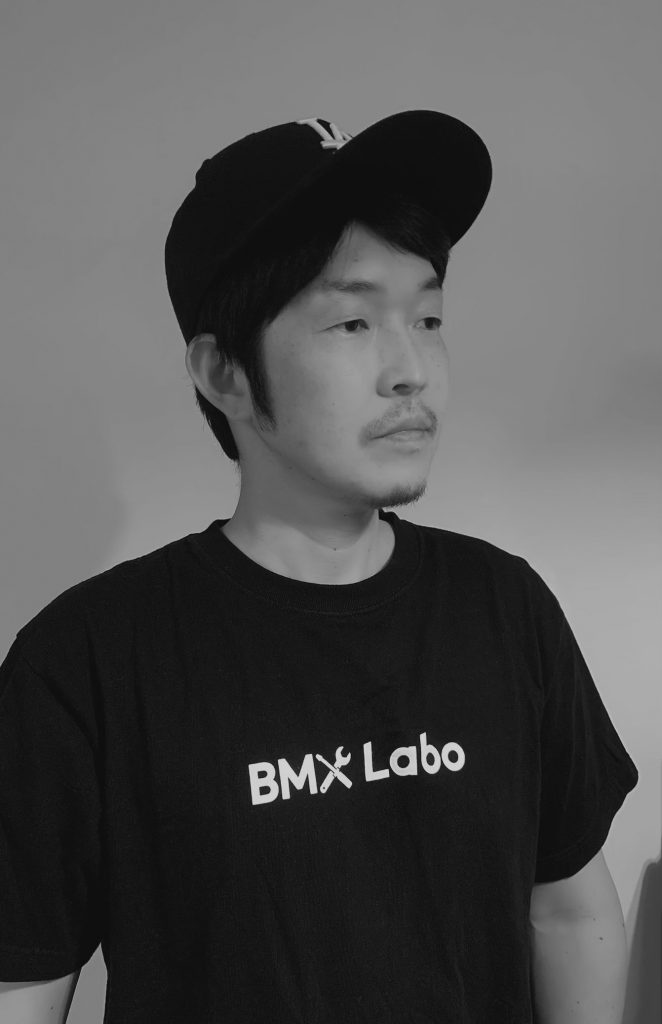
In the late ’90s, top Japanese flatland riders emerged from nowhere and started competing in the X-Games hosted by ESPN, the most prominent sports channel in the US.
By the early ’00s, it wasn’t surprising that Japanese riders were on the podium of international contests. The Japanese scene attracted riders’ attention worldwide, and they invented new techniques and trends one after another.
Yoshihiro Shinde has been one of the top riders in Japan for a long time. He continues to pursue Flatland while working as a product designer for an enterprise company on the first section of the Tokyo Stock Exchange.
He is in his forties and does not ride BMX for a living. However, when he said he wanted to master BMX, his words somehow resonated with me. Even though I had left the BMX scene, I wanted to know what the word meant.
While many riders stick with only certain tricks, he has mastered all kinds of tricks since he started riding. Stating “I want to master BMX Flatland” would probably sound cliche, but I felt he was sincere in his view of Flatland and his weighty words.
He continues pursuing Flatland to master it, entirely different from riding for love, money, or fame. Here is his story.
——
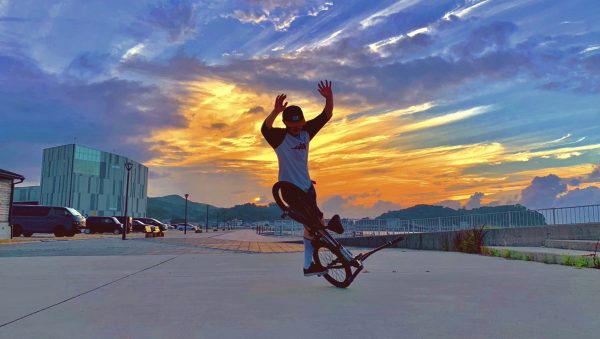
You described riding BMX flatland leading to “Tao” Art of Flatland, eventually. When did you start seeing Flatland that way?
Looking back at why I’m riding when I just turned forty, I knew riding wasn’t for money or fame. I would start riding purely for myself.
The more I did complicated tricks, the sharper my senses became, and the more I felt a sense of nature and the earth. Then, as I researched further, I resonated with the sensitivity of a master of martial arts, having read the book of five rings by Musashi Miyamoto.
After BMX became a part of the Olympic Games, people often discussed if Flatland is a sport or a culture. There is no absolute answer for it, but for me, it is a process to practice the Art of Flatland and a philosophy.
BMX flatland is a way of life, a way of gratitude, a way of enlightenment, a pursuit of truth, a spiritual discipline, and a place to feel the universal laws of nature and the universe.
When you say the word “Tao,” which invokes Judo or Kendo, more structured, whereas Flatland has more freedom and no specific form or path to master it, can you explain that bit further?
“Tao” is originally from Chinese philosophy. In my understanding, “Tao” means the universal laws of the universe and nature, moral norms, and the roots of beauty and truth.
I also believe that Sen no Rikyu was the forerunner of Japanese Design Directors and Designers. He spread the worldview of the tea ceremony in Japan through comprehensive branding that included the Chinese philosophical meaning to the worldview of tea.
Tao came to Japan in the Kamakura period (1185-1333 AD), and The Way of Tea influenced Arts and other aspects of Japanese cultures and extended many ways. However, it still preserves the original values over the years. I understand such timeless importance as “Tao.”
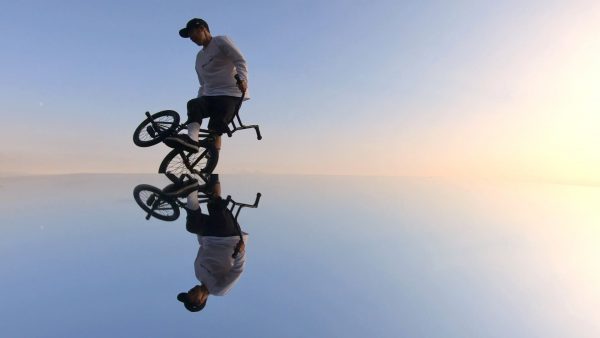
However, didn’t you ride for fame or be the best in the world in the beginning?
I had nothing, but greed when I was young. Wealth! Fame! Girls! (laughs)
A part of the dream came true slightly, but it was not a good stretch in the middle. Happiness is not proportional to greed. A superficial value is ephemeral.
For instance, the value of King of Ground (KOG) was all about how you performed and what you gained there to evolve your riding. There was a sense of unity in the place and atmosphere. It was more important than medals.
The sense of unity at competitions has diminished due to COVID recently. I see overestimation of competitiveness in a contest could be harmful to reaching a greater value.
For me, I hope the media values how much the performance represents the principles of the universe rather than medals and rankings on TVCV (laughs). The results reflect the order according to the criteria of the competition.
Ideally, I want to see riders feed off each other, get excited to see others bringing out their best, and trigger a ripple effect to all riders following. The vibes produced in the cycle introduce real bonding, a conversation of the soul and spirit.
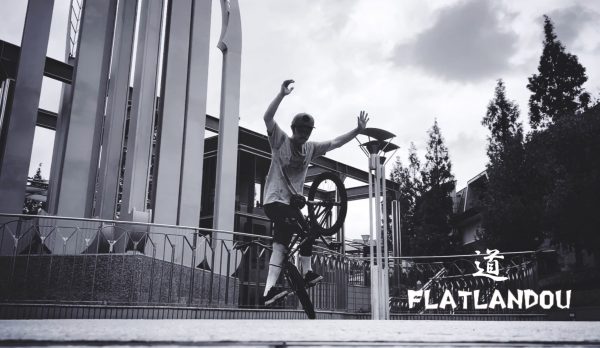
What is the greater value?
I have participated in more than 200 competitions. So naturally, it feels great to win or to be on the podium. However, the moment clearly that I can recall was when I made my best move, and I noticed that the crowd went crazy—such a moment when I pulled the tricks with the power of the audience.
I usually lose when I’m conscious of the rankings. I wouldn’t be happy if I won while people around me thought I won by defending, and it’s the same as a tasteless job.
As to the conversation with your soul or spirit, is it like a session in music?
Yeah, it is. It’s like connecting with the rider, the audience, nature, and the universe one after another.
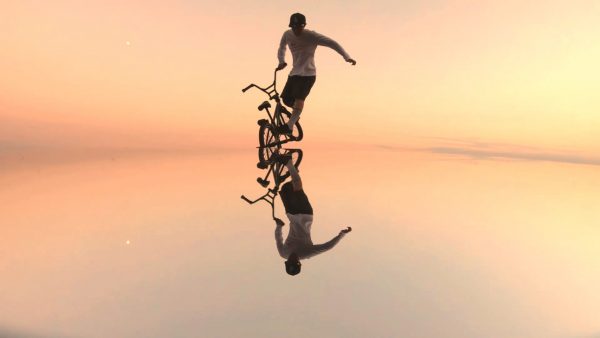
Can you explain more details about your theory that riding Flatland is the modern version of offering dance to gods?
There is a theory that dances originated channeling gods. During the Yayoi period (BC 400 to 500, women called “Miko” (priestesses) with the ability of possession appeared, and they danced to communicate with the gods during their rituals.
I hypothesize that the priestesses were highly skilled at something and had very keen senses. That ability allowed them to sense various signs, such as the coming of rain or typhoons and passed them on as divine omens. So the dance could be one of the rituals to sharpen their senses.
When I ride a bicycle, my senses are sharpened, and I receive more natural information than usual, and I imagine that this is an extension of that. For example, the effect of the moon’s gravity causes the rise and fall of the tide; by mastering the Art of Riding, you will be able to feel even the slightest difference in gravity.
Given that, I’m wondering if mastering the tricks of Flatland is the same as dancing as an offering (in this case, nature and the universe) for Gods.
A feeling of being alive and fulfilled is enriched through dialogue with nature. The more you sharpen your sensitivity, the more tasty the air and food are. You feel gratitude for the wind, temperature, sky, and a sense of integrity with the earth and the universe.
By repeating this cycle of practice and gratitude, we can get closer to the truth.
You have been contributing to the community by organizing A-Style and other competitions among riders. What do they mean from the Art of Flatland perspective by creating a place for riders to hang out and teaching riding to beginners?
Persistence and sustainability are integral parts of the Art of Flatland. Stories and history need to be inherited from the next generation. That is why competitions and communities are so important.
For example, the Parthenon in ancient Greece and the Ise Shrine were built with perpetuity. However, the Ise Shrine is still in its original beautiful state thanks to the passing on of technology and culture through the Shikinen Sengu ceremony. At the same time, the Parthenon has decayed and become a legacy of the past.
A community’s efforts to maintain and pass on places and things eventually support permanence.
Content is consumed instantly nowadays. We must ask ourselves whether our activities eventually would contribute something good in the long run and be sustainable. My activities focus on long-lasting value and inheritance to generations.
The prevalence of the Internet and smartphones changes our communication forever, and each person’s narrative has become a crucial part of communication.
By defining Art to approach the truth of the universe, we believe that the Art of Flatland could be one of the greatest values and is worthy of being handed down to future generations.
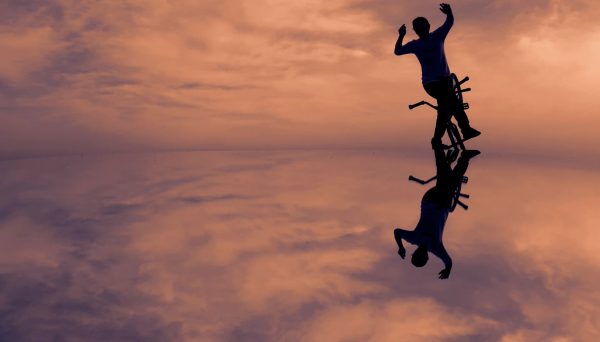
Please tell us what you expect from the next generation and what you want to pass on to them.
Please be mindful of sustainability, our narrative, and appreciate the opportunity to ride. I hope you will think about what you are leaving behind for the generations to come.
Our generation has developed many new tricks and produced a lot of world-class riders, starting with fierce contests such as KOG and continuing to the current trend. It’s your turn now. Each of you is key.
What you create and pass on to the next generation is a lifelong theme to tackle. You will be able to see enlightenment beyond grateful that you have mastered something.
Yoshihiro Shinde
In 1995, he transitioned from skater to BMX rider, was promoted to the KOG pro class in 2000, and placed 2nd in the KOG annual ranking in 2004. Since then, he has participated in more than 200 contests in Japan and abroad and has won many contests and podiums. He is still active and continues to compete.
In his 21 years of professional activities, he has held many competitions, workshops, and shows. He currently runs BMXLabo, a paid online salon that combines BMX research and online schooling. He also runs a community called BMXLove.
He usually works in design and planning at a company on the first section of the Tokyo Stock Exchange. He has won several awards for his product design, including the red dot design award for best of the best, iF design award, ASIA design award, and Good design award.
Interviewer: Yasuyuki Takeo.
In the late ‘90s, I challenged the BMX flatland contest scene in the US with York Uno and other BMX flatland pioneers. After retiring at the age of 23 due to a herniated disc, I began helping to judge the King of Ground (KOG) All Japan Championships in 2001. I took it over in 2003 and organized it until 2016.
In 2007, I started the BMX Flatland World Circuit (BFWC) with international organizers from the US and the Netherlands and ran it until 2012.
I was a guest writer and photographer for BMX Freedom magazine from 2001 to 2007 and also ran Encounter BMX Magazine from 2011 to 2016.
After taking a break from King of Ground in 2017 and leaving the BMX scene, I currently work as a software engineer and occasionally contribute to the cultural aspects of BMX.

Amazing interview.
Beauty, Wisdom, Harmony!
From Ursula K. Le Guin’s translation of the Tao Te Ching: “And the wise soul predominates without dominating, and leads without misleading, And people don’t get tired of enjoying and praising one who, not competing, has in all the world no competitor.”
Definitely goes much deeper than, “it’s fun to ride my bike”. Amazing interview. Thank you to all involved for the opportunity to see inside the mind of a master.
Another rad interview …..thank you , E ! I just watched the Ares Volume 4 ( 2007 . ) video . Shinde ,of course has cool lines throughout it , mixed with tech -style and his signature ways of linking tricks . This interview really shows his views , thoughts and motivations on Flatland and life as a whole . Every edit , video part that he’s produced , ridden in……..they’re all awesome with SLLLLAMMMMMED links from him……top / legend rider …….this is a MUST READ interview !
Also …..thank you , Mr. Takeo for this interview . You’ve been a excellent rider , photographer , and overall media backer / supporter ,of the BMX scene in Japan for many , many moons . Always exposing and showcasing Japan’s amazing riders…..past , present and future. Thank you , sir….
Man. Sheer wisdom. What a great interview!
Fantastic interview… thoroughly enjoyed this…
Shinde is one of my favorite to watch….always working on something new and interesting on his bike….true flatland mind!Arigato Yoshi….